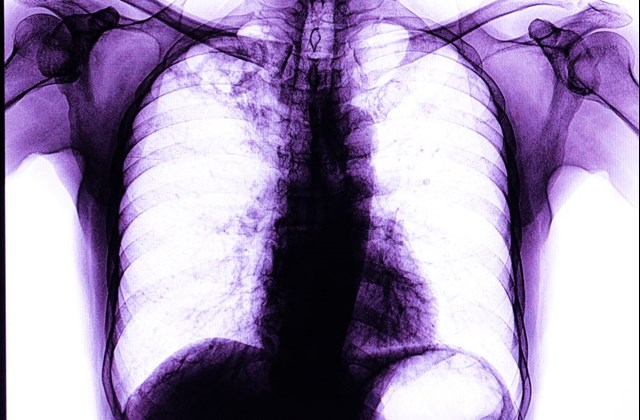
Xray of a patient with active pulmonary tuberculosis. Image by Shutterstock
Just as first impressions set the stage for the entire course of a relationship, first impressions set the stage for how the cells of our immune system react when meeting a new microbe, according to Israeli researchers at the Weizmann Institute of Science.
This new insight led the researchers to develop an algorithm that may predict the onset of such diseases as tuberculosis. Their findings were published July 22 in Nature Communications.
The phenomenon is explained by lead author Roi Avraham from the Institute’s Biological Regulation Department: “When immune cell and bacterium meet, there can be several outcomes –the immune system can kill the bacteria; the bacteria can overcome the immune defenses; or, in the case of diseases like tuberculosis, the bacterium can lie dormant for years, sometimes causing disease at a later stage and sometimes remaining in hibernation for good. We think that the junction in which one of those paths is chosen takes place some 24 to 48 hours after infection.”
Noa Bossel Ben Moshe and Shelly Hen-Avivi in Avraham’s group began by introducing immune cells from blood samples to Salmonella bacteria. Using a method developed in recent years, partially at the Weizmann Institute, they sequenced the gene activity in thousands of immune cells to see what each cell looked like as it responded to the Salmonella and mapped the activation profiles of each.
This process revealed patterns not seen in standard lab tests, and it seemed to confirm their hypothesis – there were indeed differences that enabled them to trace responses from the initial meetings to the later outcomes.
Hoping to connect their results to real-time blood tests in real patients, the scientists developed an algorithm that would then enable them to extract similar information individual blood cells from standard data sets.
“The algorithm we developed,” said Bossel Ben Moshe, “can not only define the ensemble of immune cells that take part in the response, it can reveal their activity levels and thus the potential strength of the immune response.”
The first test of the algorithm was in blood samples taken from healthy people in The Netherlands. These samples were infected, in a lab dish, with Salmonella bacteria, and the immune response recorded.
Comparisons with existing genomic analysis methods showed that the standard methods did not uncover differences between groups, while the Israeli algorithm revealed significant differences tied to later variations in bacteria-killing abilities.
Then they tested whether the same algorithm can be used to diagnose the onset of tuberculosis, which is caused by a bacterium that often chooses the third way – dormancy — and thus can hide out in the body for years.
Millions still die of TB every year
Up to a third of the world’s population carries the tuberculosis bacterium, though only a small percentage of these become ill. Still, some two million die of the disease each year, mostly in underdeveloped areas of China, Russia and Africa.
The researchers applied their algorithm to blood-test results found in a British database that followed patients and carriers for a period of two years. They found that the activity levels of immune cells called monocytes could be used to predict the onset or course of the disease.
“The algorithm is based on the ‘first impressions’ of immune cells and Salmonella, which cause a very different type of illness than mycobacterium tuberculosis,” said Hen-Avivi. “Still, we were able to predict, early on, which of the carriers would develop the active form of the disease.”
Once tuberculosis symptoms appear, patients have to take three different antibiotics over the course of nine months, and antibiotic resistance has become rampant in these bacteria. “If those who are at risk of active disease could be identified when the bacterial load is smaller, their chances of recovery will be better,” explained Avraham.
The researchers intend to expand their own database on tuberculosis and other pathogens so to as to refine the algorithm and work on developing the tools that may, in the future, be used to predict who will develop full-blown infectious diseases.
